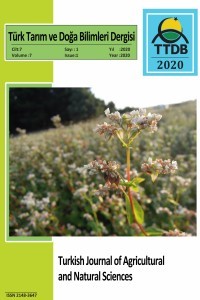
Türk Tarım ve Doğa Bilimleri Dergisi
Yazarlar: Ferhat KIZILGEÇİ, Mehmet YILDIRIM
Konular:-
DOI:10.30910/turkjans.633593
Anahtar Kelimeler:Wheat,Canopy temperature
Özet: In recent years, many researchers have been using the spectral reflectance instruments intensively in determining the relationship between grain yield and quality traits in some development stages of wheat. This research was carried out to determine the relationship between grain yield and quality traits with the physiological values measured by some spectral reflectance instruments at heading stage of durum wheat genotypes in Sirnak conditions during 2015-16 and 2016-17 growing season. In the study, 2 commercial varieties (Cesare and Fırat 93) and 7 advanced durum wheat genotypes were used. According to the results of statistical analysis, significant differences were found in year, genotype and year x genotype interactions of the examined traits. The data obtained from the study was changed between 3932,0-6044,5 kg ha-1 in grain yield, 22.98-47.96 g in thousand kernel weight, 75.4-85.8 kg hl-1 in test weight, 14.96-20.45% in protein content, 59.3-63.24% in wet gluten, 27.36-47.55% in starch content, 14.65-16.53 in semolina color (b) value, 45-53.6 chlorophyll content (SPAD), 21.5-27.3°C in canopy temperature (CT), 0.42-0.85 in normalized differences vegetation index (NDVI) value and 2.85-3.68 in leaf area index (LAI) value. The relationship between the physiological measurements with grain yield and quality traits of durum wheat at the heading stage has showed differences between years. It was determined a positive relationship between SPAD and protein content and wet gluten in both years, and it is thought that more extensive studies should be done in order to evaluate SPAD as a selection criterion for development of high quality genotypes in this stage.